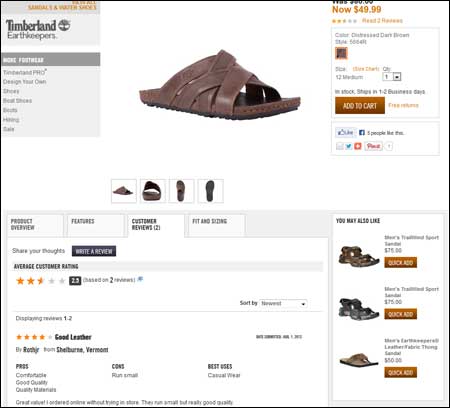 If you’re running an online store these days, showing ratings & reviews of your products left by other customers has essentially become a requirement for keeping up. If you’re not carrying product reviews, you’re probably leaving money on the table.
If you’re running an online store these days, showing ratings & reviews of your products left by other customers has essentially become a requirement for keeping up. If you’re not carrying product reviews, you’re probably leaving money on the table.
According to a 2011 study by iPerceptions, nearly two-thirds of the customers studied were more likely to order from sites that included reviews by users. Reviews vendor Reevoo reports an 18% upward lift in sales for sites with customer reviews.
In addition, product reviews provide great content for search engines to pick up. They tend to be keyword-rich, and the content is generated by someone else. This results in pages that stay fresh, another plus for search engines.
So whether you’re not currently showing reviews but want to start, or you are already showing reviews but want to do it better, here are some tips to help you maximize their potential.
Including Reviews On Your Site
- Include all your reviews, even your negative ones. One concern I hear from smaller businesses about customer reviews is their fear of having negative reviews on the site. But the truth is, there is a lot of value to negative reviews.When shoppers see some negative reviews, they feel they can trust the validity more. They know that reviews are coming from real people. They know you are allowing them to see the whole picture, implying that you have confidence they will be satisfied. See #12 below about responding to negative comments.
- Show a Reviews Summary separately from the full Reviews Content. In all but the most basic of applications, product reviews will include the ability for the reviewer to give the product a rating, usually expressed in one to five “stars”, along with at least a chance to write their thoughts about the product. As noted above, this can add great content to your website, but you don’t want it to get in the way of more important elements of the page.On your Product Detail page, include your Reviews Summary (typically just a graphical representation of the average number of stars from all reviewers) high on the page, above the fold. A good place to put it is either right below the product name, or next to the price & Add To Cart button. But leave the actual Reviews Content at the bottom of the page. If people want to read the reviews, they can easily do so, but your product images, description, call to action, etc., should all be above the fold.On other pages, such as the Product Category pages, you’ll want to use the Summary only.
- Include Review Summaries on your Site Search results pages. When visitors use your site’s Search function, you should start salivating. Those users are so much more likely to make a purchase. So use all the tools you have to sell to them. For products that have been reviewed, put the Reviews Summary right there in the search results to entice the visitor to check out the product. Review information isn’t just for Product Category and Detail pages. They should be on your What’s New page as well!
- Set your default sort order to ‘Newest to Oldest’. Most review systems will allow the site user to sort the reviews a number of ways such as Most Favorable first, Least Favorable first, by date, etc. It’s common for merchants to set the default sort order to show the most favorable first. However, I prefer to show the most recent first so that as search engines crawl your site, they are most likely to find the most recently added content on the page, especially after your products get enough reviews that there are multiple pages of them.
Gathering Reviews From Your Customers
- Don’t add your own phony reviews. It’s usually pretty obvious to spot reviews written by the company itself. Just don’t do it. You’ll lose the trust of your customers quickly. Instead follow more of the tips below to build your array of reviews.
- Send an email to purchasers after they have ordered. The best way to obtain new reviews is to simply ask for them. After a customer has placed an order, allow time for the product to ship and be used, and then send them an email simply requesting that they come back and leave their feedback.The email should be tailored to the purchaser to include a list of the products they ordered, along with photos to jog their memory. Each item in the list should include a link back to the review form for that specific product.For most items, waiting about three weeks is generally long enough to ensure that they have used the product, but not so far out that they have forgotten about their experience. If your products are perishable or have a shorter shelf-life, two weeks might be better.
- Use Emails in other ways to request reviews. If you are adding reviews for the first time, it’s a good idea to send an email to everyone who has purchased in the past six to twelve months to ask them to come back and review. The same guidelines as above apply here.You can also add content to your email receipts to request a review. This might have less impact than the 21 day reminder, but some people will be more likely to open and read the email receipt. Again, include a link to the exact page to review that specific product in the email.
- Consider offering incentives for leaving reviews. I like to recommend this as a later resort because it can lead to the perception of “buying” reviews, and it can possibly get expensive. However, when executed properly, offering an incentive such as a discount on a future purchase or a free sample can increase the take rate on requesting reviews. Definitely only use it in conjunction with emails sent to known purchasers.
- Verify reviewers as actual product purchasers. It’s fine to accept and post reviews from anyone that you are confident are legitimate, but when you can verify a review as having come from someone who did indeed purchase the product online, denote that in the review posting. This will add a lot of trust to your readers looking at the reviews. Many current review systems offer automatic verification based on archived order info, doing the work for you.
- Tailor review specs to each product. Your system may just ask for an overall rating and a comment, but if you can add some additional questions, tailored to the uses of each product, they can be more persuasive for your users. For example, review questions for a shirt might include whether it runs big or small for its size, or if the color depicted on the website is accurate. Don’t require that your reviewer answer too many questions, but additional questions like these can give your readers more information.
- Don’t require someone to create an account to leave a review. While this can be a way to verify users as in #8 above, it will also significantly reduce the number of reviews you get. It’s an unnecessary step that you are forcing the user to take, and most of them will just leave at this step. If creating an account is a barrier to ordering (and it is!), then it is certainly a barrier to leaving a product review.
- Respond to negative comments in a timely manner, publicly. As noted in #1 above, a negative review should not be filtered out during moderation, but posted. And when at all possible, a response should be posted right there next to it, hopefully with a solution that the customer and others would find acceptable. Doing so in a timely manner can turn a negative review into a positive reflection of your customer service for all the world to see.
If you’re not showing product reviews on your store’s site already, I think there are fewer improvements you can make to the site that would be more important. Put together a plan right now to implement reviews. If your site is currently showing reviews, see how you can improve things and measure the difference!
Now review this blog post in the comments section and leave your own tips for making product reviews more effective.








